OnePlus 9 Pro Review: The mature flagship
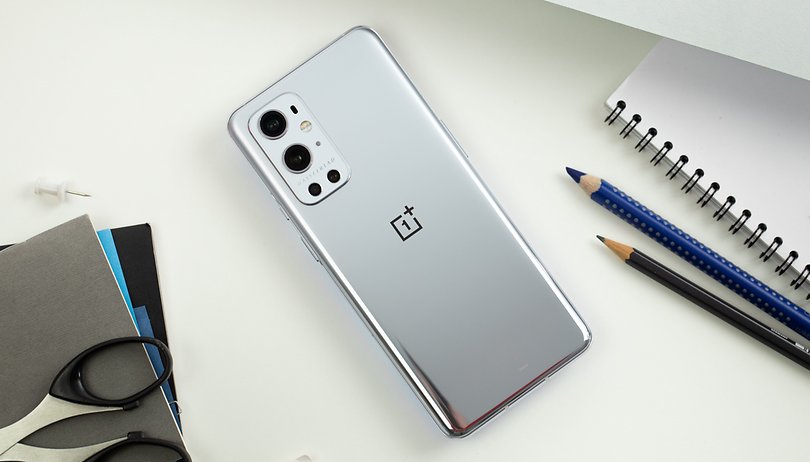

Aiming for the moon seems to be OnePlus' motto with the OnePlus 9 Pro. Launched earlier today, on March 23, 2021, this phone is clearly positioned as the no-compromise flagship that aims to further close the gap with other high-end Android competitors. This 'gap' was mainly in the camera performance of OnePlus flagships. And that is exactly what Oneplus aims to fix with the OnePlus 9 Pro. Does the company's newfound partnership with the camera experts at Hasselblad help its cause? Let's find out!
Good
- The Fluid Amoled 120 Hz display
- Snapdragon 888
- 65W wired and 50W wireless Warp Charge
- The versatile camera module
- Clear improvements to the camera
- IP68 rating
- 65W charger included
Bad
- Classy design but too conventional
- The zoom is still limited
- The "gaming pro" mode is too gadgety
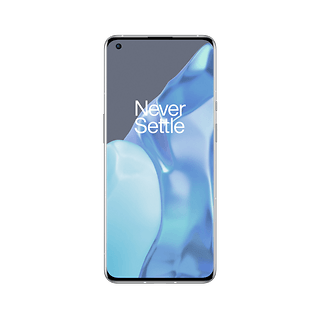
My opinion on the OnePlus 9 Pro in brief
The OnePlus 9 Pro is obviously not the first attempt by OnePlus at making a flagship. It's been at least two years since OnePlus began its move upmarket. This year, however, the catalogue also seems to have more or less 'stabilized.' For us the west, OnePlus' offerings are simple: The 'basic' OnePlus 9 starts at 699 EUR and the OnePlus 9 Pro starts at 899 EUR. This is the same price at which the company announced the OnePlus 8 and OnePlus 8 Pro last year. For those of you reading this in India, there is a third handset - the OnePlus 9R which at least for the time being will be restricted to India.
Coming back to the OnePlus 9, the specs on the thing is right up there with the best. Snapdragon 888, Fluid AMOLED QHD+ screen with 120 Hz refresh rate, quad 48+50 MP camera module and 4500 mAh battery - you name it. The phone has it. As you might have guessed, those are some serious flagship specs right there. And at a starting price that is almost equal to the Galaxy S20, the OnePlus 9 Pro surely cries for your attention.
On paper, therefore, the OnePlus is already looking to be a very good value for money flagship - just like the Xiaomi Mi 11. But that's nothing new. So let us now find out what the big deal is with the OnePlus 9.
Historically, the camera performance exhibited by previous OnePlus flagships always worked against the company. And this time, the company seems to be determined to fix the problem.
Neat design but way too conventional?
The OnePlus 9 Pro has a fairly classic design for a flagship and sports the usual curved screen/glossy glass back/metallic edges theme that we have begun to associate wit flagships these days.
In short, I liked:
- the silver Morning Mist colour and the mirror effect it gives off
- the curved screen
- the rather thin camera module
- IP68 certification
I did not like:
- the fact that there is no MicroSD slot
- the fact that the design is very 'conventional'

For this review, OnePlus sent us the Morning Mist colour option. This is a nice colour that gives off silver and black tones and the reflections create a very nice mirror effect. At certain angles, the rear panel gives off an opaque look, a bit like a morning mist. In any case, the effect is very convincing. As expected, the OnePlus 9 Pro gets a curved display (an option that is no longer as popular as it used to be). That being said, the degree of curvature is quite within 'tolerable' limits. The smartphone is otherwise quite thin and quite light for a OnePlus at 192 grams (compared to 199 for the OnePlus 8 Pro).
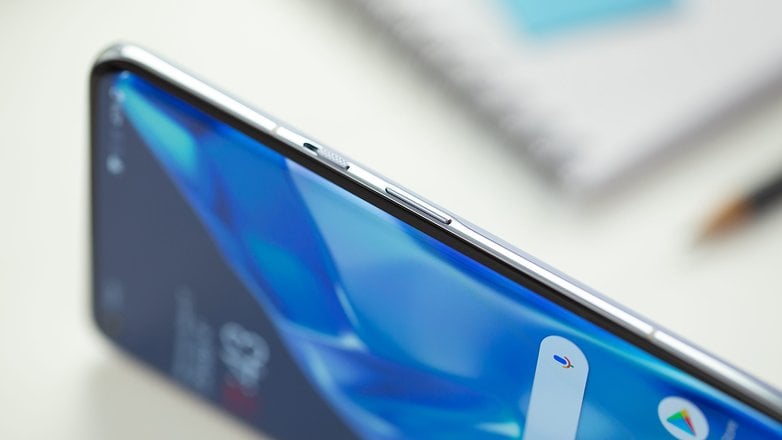
The camera module on the back follows the design of the previous OnePlus 8/8 Pro/8T series. The ultra wide-angle and main sensors are perched on top of each other vertically while the monochrome sensor and telephoto lens are aligned horizontally just below, topped with the "Hasselblad" logo.
I didn't notice any play as I ran my fingers over the volume and power buttons, the "Alert Slider" click is firm and crisp, and what can I say about the haptic feedback except that it's delightfully (yes, to each his own, don't judge) precise. I also appreciate that the phone gets IP68 certification but a MicroSD port continues to be ignored.

Overall, the design of the OnePlus 9 Pro is really good. Albeit some elements are a little too much for my taste. I don't feel enough differences from last year's iterations. But the very nice colour and its metallic effects are quite worthy of a premium smartphone.
A smoother, more energy-efficient Amoled LTPO screen
The OnePlus 9 Pro packs a 6.7-inch Fluid AMOLED display with QHD+ resolution (1440 x 3216 pixels), in the 20:9 aspect ratio. The panel also supports 120Hz refresh rate (adaptive) and a maximum brightness of 1300 nits. The phone also boasts of 360Hz touch sampling rate.
In short, I liked:
- the 120 Hz refresh rate
- the Hyper Touch sampling rate of 360 Hz
- the peak brightness value of 1300 nits
I didn't like:
- The "smart" adaptive refresh rate.

As the case has been with OnePlus flagships, the AMOLED screen is excellent. This time around, the OnePlus 9 Pro benefits from an update to Fluid Display technology in its second generation. The major addition is the integration of LTPO (low-temperature polycrystalline oxide) technology that has a positive impact on the battery. If that wasn't all, the display is claimed to be more responsive and stable in terms of framerate.
I have to say that the OnePlus 9 Pro's screen was quite fluid and the browsing and gaming experience was great. The latter particularly because of the 360Hz touch sampling rate.
On the other hand, I'm a little more sceptical about the adaptive refresh rate. By activating the native FPS counter of Android 11, I could see that we went from 120 Hz on Call of Duty: Mobile to 60 Hz on Youtube or Netflix. But OnePlus says it can go as low as 1 Hz for reading text or viewing photos.
The problem? I couldn't reach those values. In fact, the lowest rate I was able to get down to was 30 Hz and that was only when I was using the keyboard in some messaging apps or just in search bars on Google, Maps, Spotify or Youtube.

OnePlus usually uses Samsung panels for its displays, which are always among the brightest on the market. The 1300 nits scores posted by OnePlus helps it make it to the top of the range, although the Samsung Galaxy S21 Ultra 's screen is brighter at1500 nits.
The OnePlus 9 Pro's screen also comes with a whole host of features like MEMC (adding frames to smooth the display), HDR10+, 10-bit colour depth, ambient light detection etc... So many features that I can't evaluate with the means and time at my disposal.
Overall, I found the screen of the OnePlus 9 Pro to be excellent. I'm not convinced by all the marketing around the smart adaptive refresh rate. But the multimedia experience is among the smoothest on the market.
Snapdragon 888 is a beast!
The OnePlus 9 Pro packs the Snapdragon 888, the latest high-end 5G SoC from Qualcomm. We find the tri-cluster structure with one Cortex-X1 clocked at 2.84 GHz, three Cortex-A78 clocked at 2.42 GHz, and four Cortex-A55 at 1.8 GHz.
In short, I liked it:
- for playing some games at 90 or 120 FPS
- because of the raw power of the Snapdragon 888
I did not like:
- the Fnatic mode that does not significantly increase performance
- the unstable framerate after 30 minutes of play
As with the Xiaomi Mi 11, some graphics benchmarks don't work since they are outdated.
OnePlus 9 Pro
| Benchmarks | OnePlus 9 Pro | Xiaomi Mi 11 | Samsung Galaxy S21 Ultra |
|---|---|---|---|
| 3D Mark Wild Life | 5670 | 5702 | 7373 |
| 3D Mark Wild Life Stress Test | 5698 | 5697 | 5175 |
| Geekbench 5 (Single / Multi) | 1112/3633 | 1085/3490 | 942 / 3407 |
| PassMark Memory |
31891 | 26.333 | 31.752 |
| PassMark disk |
112370 | 120.430 | 81.108 |
I actually ran 3 test sessions without and 3 with the "gaming pro" and Fnatic modes, which are supposed to improve performance. The benchmark I used showed no noticeable difference. I've already written about it in more detail, but apart from Huawei's performance mode, I find little use for the various options that promise to "boost" your gaming experience.
I do, however, welcome the contextual menu of the gaming pro mode, which can be brought up in the middle of a game by swiping from the top left corner of the smartphone when in landscape mode. The ability to create clips retroactively, after an epic gameplay phase, is a very nice addition. On the other hand, you'll have to explain to me how useful it is to be able to view WhatsApp, Telegram or even Instagram in windowed mode while you're playing.

While most of 3DMark's tests didn't work on the OnePlus 9 Pro because it was too powerful, 3DMark's Wild Life and Wild Life Stress Test benchmarks did.
These two tests simulate intense gaming use of the smartphone over a short period of time (1 minute) for Wild Life and over a long session (20 minutes) for Wild Life Stress Test. The idea is to see how well the smartphone is able to maintain a constant level of performance in an "extreme" scenario in the short and long term.
And on the 1-minute Wild Life test, the performance of the OnePlus 9 Pro was mixed to say the least in terms of stability. A framerate that fluctuates between 24 and 42 FPS while the temperature remained pretty much constant and below the overheating threshold is not crazy. Especially when OnePlus prides itself on being one of the only manufacturers to allow you to play certain games in 90 or even 120 FPS.
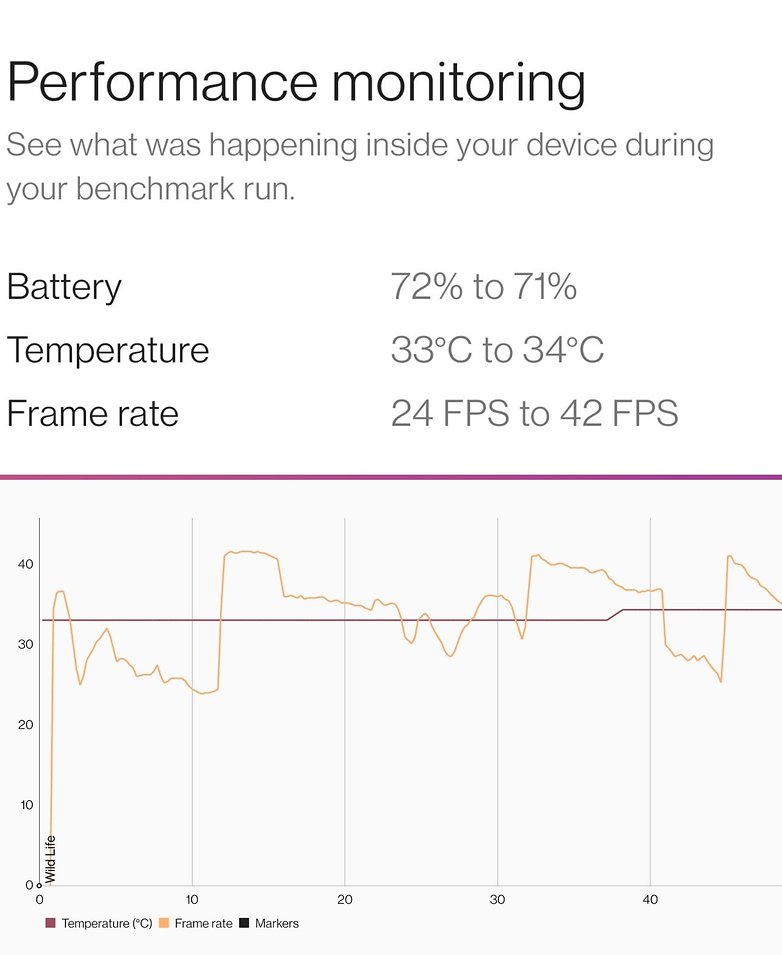
On the Wild Life Stress Test benchmark of 20 minutes, we can note an abrupt drop in performance from the fourth loop of test (so 4 minutes). If you look at the infographic in the middle of the illustration below, you can see that the difference between the first test loop (green curve) and the sixteenth (purple curve) is really noticeable.
As the temperature rises, things get worse and the framerate goes all over the place and drops to 20 FPS when the smartphone is barely above 40°C.
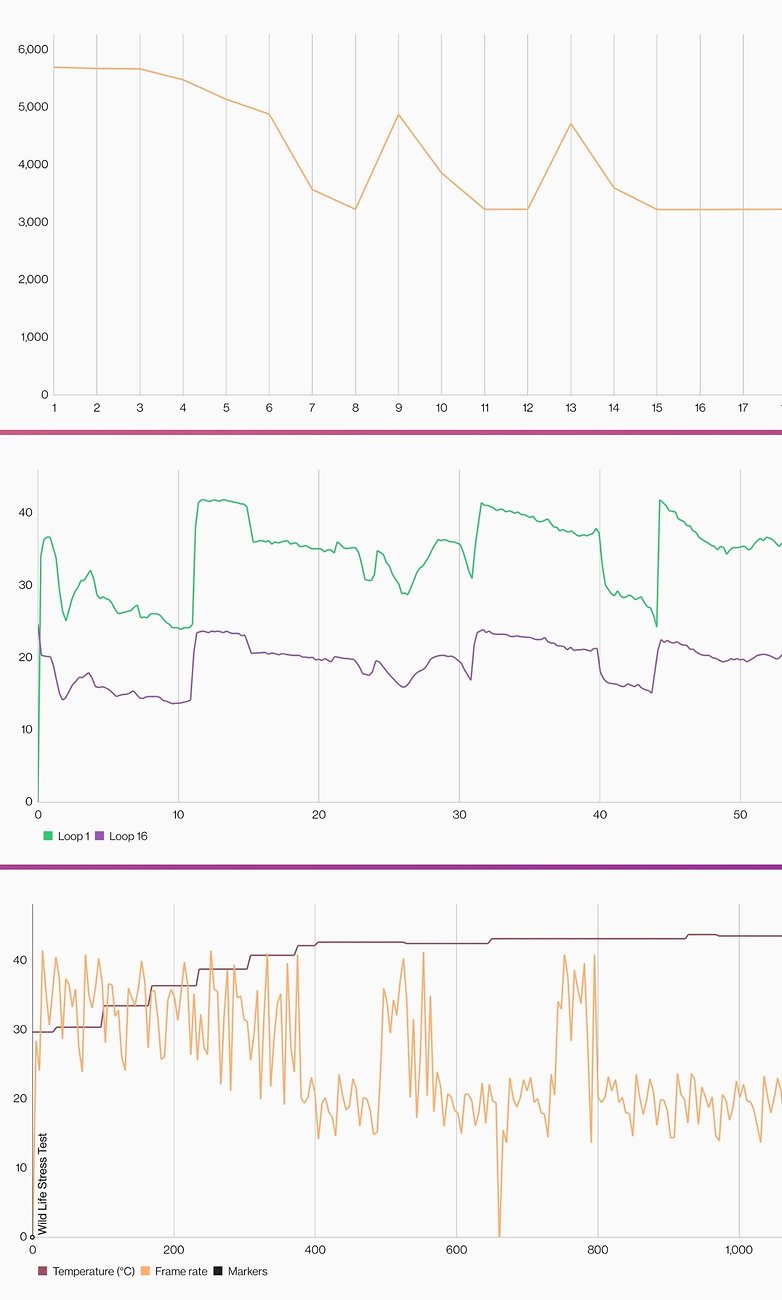
OnePlus, however, has taken the basics of the OnePlus 8T for the cooling system by enlarging the vapor chamber and using thicker graphite layers as well as larger copper films to better manage temperature control.
Impossible as it is to verify these claims since I have not disassembled the smartphone but I leave this cruel but necessary task to the specialists that you all probably already know. Specifically, the OnePlus 9 Pro does not overheat too much but seems to have pushed the sensitivity of its thermal throttling a little too much.
Rest assured, I didn't feel any slowdown during my long daily gaming sessions that on average last 1.5 hours. I also didn't notice any serious framerate drops with my own eyes. Again, I remind you that these Wild Life benchmarks simulate an unrealistic and really intense usage that most users will not practice anyway.
The OnePlus 9 Pro is therefore obviously a high-end smartphone among the most powerful on the market. The gaming pro mode is superfluous in my opinion, apart from its retroactive clips feature and the temperature control is perhaps a bit too harsh in limiting performance too quickly or too early.
The cameras: Definite improvements!
The OnePlus 9 Pro packs a quad camera module co-developed with Hasselblad with the following specs:
- 48 MP wide-angle prime lens: Sony IMX789, 1/1.43" (sensor size), 2.24μm (pixel size with 4-in-1 binning), EIS/OIS, f/1.8 aperture, 23mm equivalent
- 50 MP ultra-wide angle lens: Sony IMX766, 1/1.56" (sensor size), freeform lens, f/2.2 aperture, 14mm equivalent
- 8 MP telephoto lens: f/2.4aperture, 1.0μm (pixel size)
- 2 MP monochrome sensor
On the OnePlus 9 and OnePlus 9 Pro, the collaboration with Hasselblad is in terms of software only (as is the case between Huawei and Leica.) So we stay on the same Sony IMX689 main sensor that we have already seen on the OnePlus 8, 8 Pro and 8T. The OnePlus 9 Pro, however, benefits from a newer sensor called the Sony IMX789.
The highlight of this Hasselblad camera module is the colorimetry. OnePlus promises that its new natural color calibration solution, which is based on Hasselblad's expertise, will result in more accurate, and therefore more realistic, photos.
In short, I liked:
- the contrast and dynamic range with the wide angle camera
- the versatility of the ultra wide angle+wide angle+telephoto combo
did not like:
- that the zoom range is still too limited
- color inconsistencies between different lenses

The photos of the OnePlus 9 Pro with the main sensor
The highlight of the 48 MP main sensor is the support for native dual ISO, 12-bit RAW which is apparently the new buzzword for photophiles, and DOL-HDR. DOL stands for "Digital Overlay" and consists of taking several shots with different exposure values and then combining them to optimize the dynamic range.
And in daytime shots, I must say that I was rather surprised by the very good management of the complex dynamic ranges. Take a look at the image below to see what I am saying.

I still find that the camera module tends to make the greens look 'less green'. But it's not the purest, most realistic rendering either. Which I don't care about personally as long as the colorimetry doesn't look too artificial, which is far from being the case here.

The main sensor supports 4-in-1 pixel binning with Sony's 2x2 OCL technology, which involves layering a single micro-lens on top of each group of 4 pixels instead of having one per pixel. This makes focusing faster and more accurate.
You have the option of shooting at full resolution, which is 48 MP instead of 12 MP. But I didn't feel the need or the desire to do so, as the exposure was much less well managed.

The level of detail is still satisfactory and, although you can see some motion blur artifacts related to the water at the bottom center of the image below, I find the surface of the Sprée to be sufficient and therefore the digital noise remains very contained.

Usually, previous OnePlus flagships had this annoying tendency to draw a veil over shots, mostly due to overly aggressive smoothing. The AI was clumsily trying to reduce the digital noise, but it was making the shots lose their roughness. This is perhaps the biggest improvement I've seen on this camera module, this smoothing haze is almost gone, in my opinion.

The OnePlus 9 Pro's ultra-wide angle photos
There's also a 50 MP Sony IMX766 ultra-wide-angle lens on both the OnePlus 9 and OnePlus 9 Pro, which is also an "upgrade" from the 48 MP OnePlus 8 Pro sensor. The main difference is the inclusion of so-called "freeform lenses."
These are several lenses with an irregular surface and superimposed asymmetrically with respect to their axis. The idea is to direct the captured light in such a way as to limit the distortion effect typical of large FOV optics.
Here, OnePlus promises to contain the distortion effect to less than 1%. A figure that does not mean much as it is, but the freeform design on an ultra wide-angle lens has already proven itself on the Huawei Mate 40 Pro, for example.
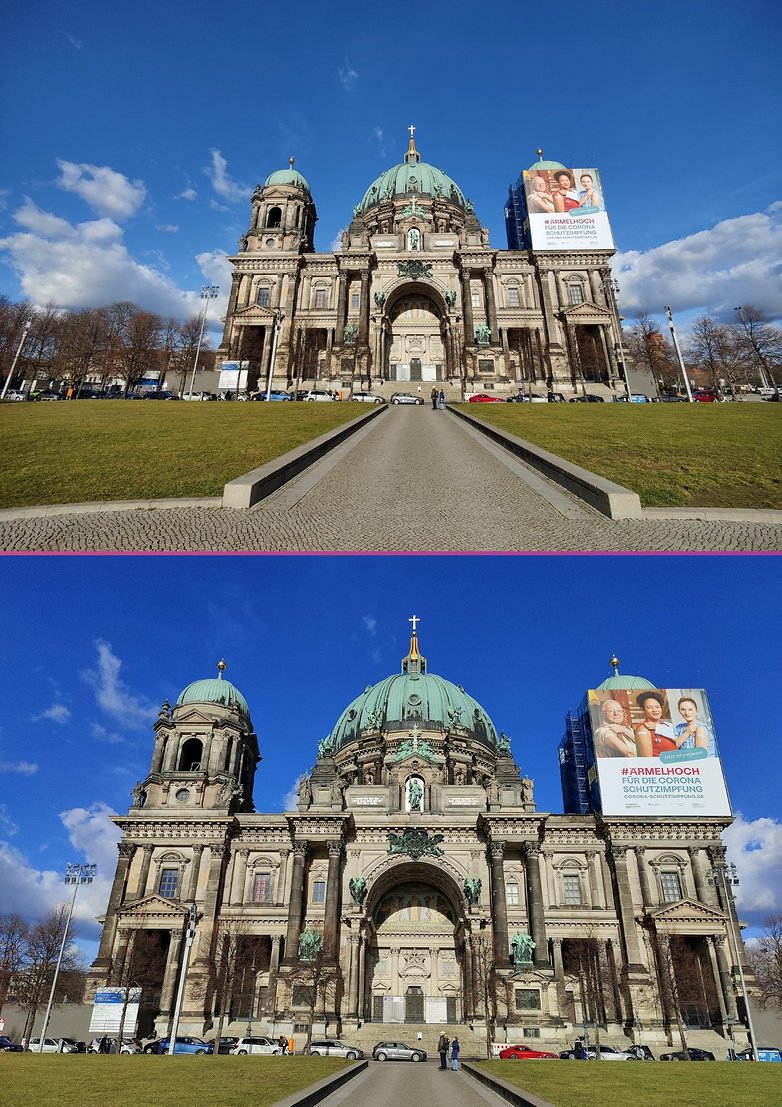
I'm not going to get into absurd percentage measurements, even though my colleague Stefan will probably slap me on the wrist with a scientific formula that is obvious. I'm basing myself on my feelings and my observations with the naked eye.
I can't tell you that the distortion at the edges of the image is less than 1%, but I can say that it is limited enough that I don't notice it.
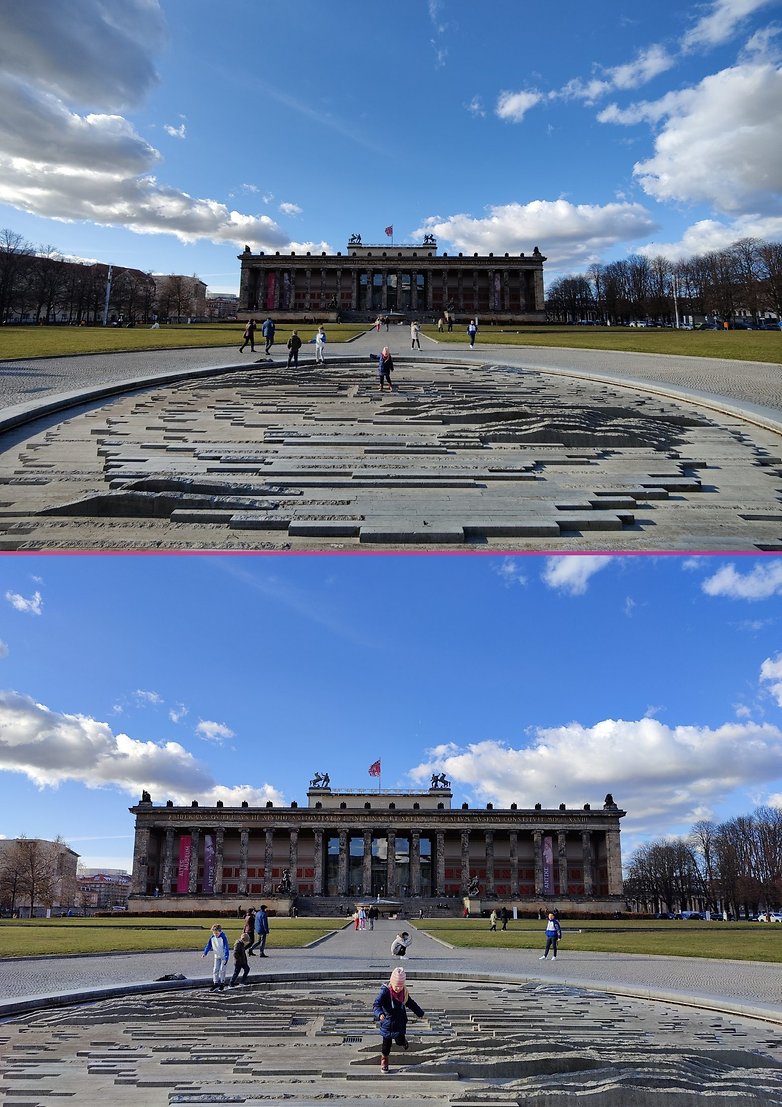
On the other hand, one must obviously note a decrease in the level of details which is logical on this kind of lenses. I also regret a lack of coherence in terms of exposure and colorimetry between the wide-angle and ultra-wide angle lenses.
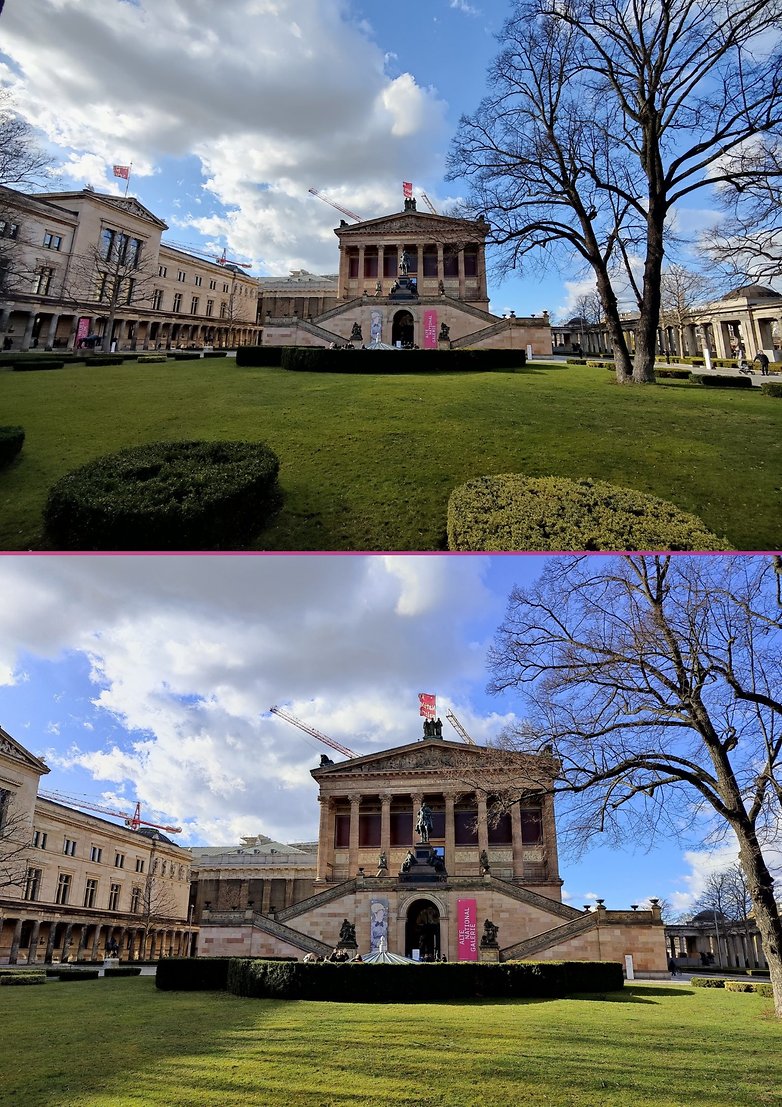
The image below illustrates this inconsistency perfectly. Look at the blue of the sky and the ochre of the building, the colors are much more bland in ultra wide angle and the shot seems almost overexposed unbalancing the dynamic range and the contrast.
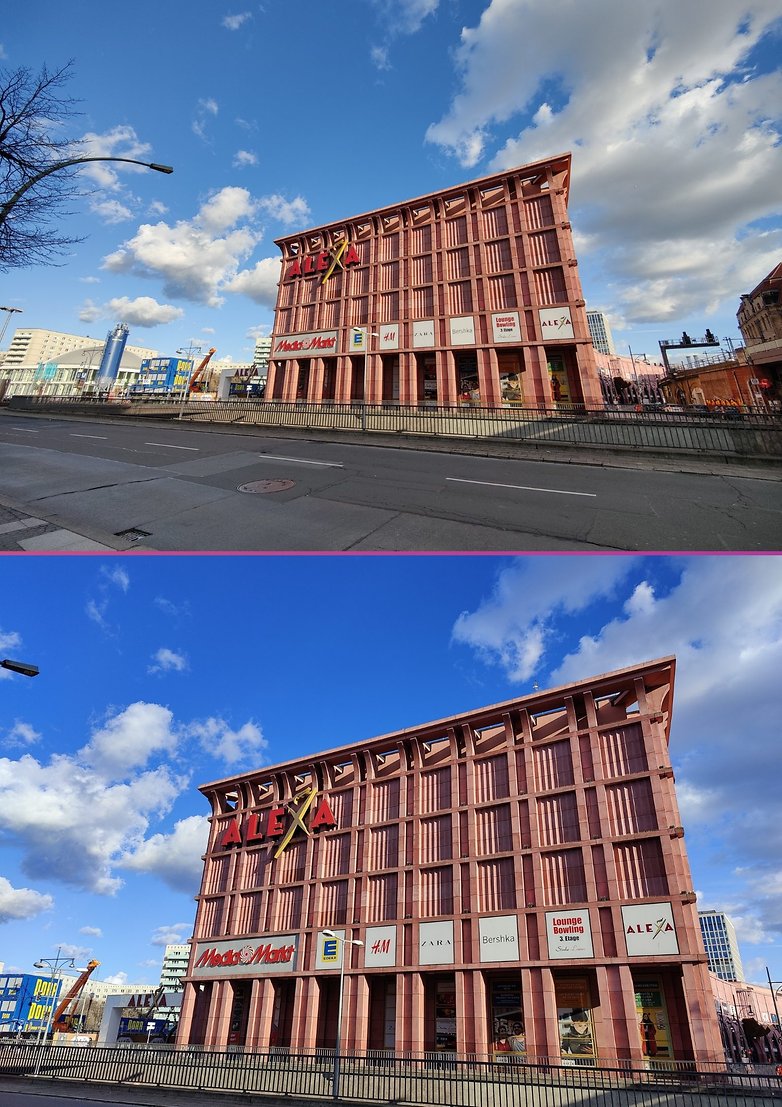
OnePlus 9 Pro zoom shots
Once again, the OnePlus 9 Pro retains the exclusivity of the dedicated telephoto lens. This lens (77mm equivalent) is capable of a x3.3 optical and digital zoom up to x30. It also features optical stabilization (OIS) to limit motion blur.
As long as you stay on the beaten path of x3.3 optical magnification, the loss of detail is limited. I tried to push to x10 which is the limit of what the telephoto lens can produce without being unusable. We immediately see that the shots are noisier but they remain quite correct in my eyes.

For all that, we're clearly not at the niceau of a Huawei or Samsung photophone. I also noticed that the focus could be a bit fickle once the x3.3 magnification was exceeded.

The x30 shots are almost all unusable and totally covered with a bunch of pixels without any detail. Granted, not many people have fun doing x30 zoom shots from right to left and I've probably kept my spoiled child habits when I used the Galaxy S21 Ultra and its ultra versatile x5 and x10 zoom.

But I think it's a shame not to have an optic with a higher resolution and a faster aperture like f/2.0 instead of f/2.4 to capture more light and therefore more details. Take a look at the image below and note the difference in colorimetry and exposure between the two photos at the top left (wide angle) and right (x3.3 zoom). The white balance is much cooler and it feels like the lens isn't capturing as much/sufficient light.
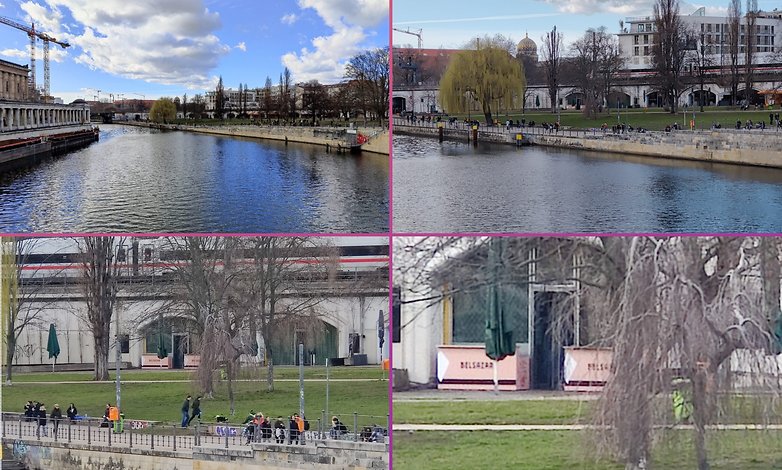
The OnePlus 9 Pro photos at night
At night, I found the OnePlus 9 Pro to perform quite well. The dedicated night mode, NightScape, only works with the ultra-wide angle and main wide angle lenses. But in good light conditions, with urban lighting, it doesn't force the exposure too much and the shots remain "naturally" nighttime.

I find that the OnePlus 9 Pro handles strong light sources rather well by preventing urban lighting from totally burning out the image, for example. Digital noise is obviously present and the sharpness therefore takes a hit.

On the other hand, when you shoot a darker scene, the night mode will tend to overexpose the shot even if it means almost completely losing its "night" look.
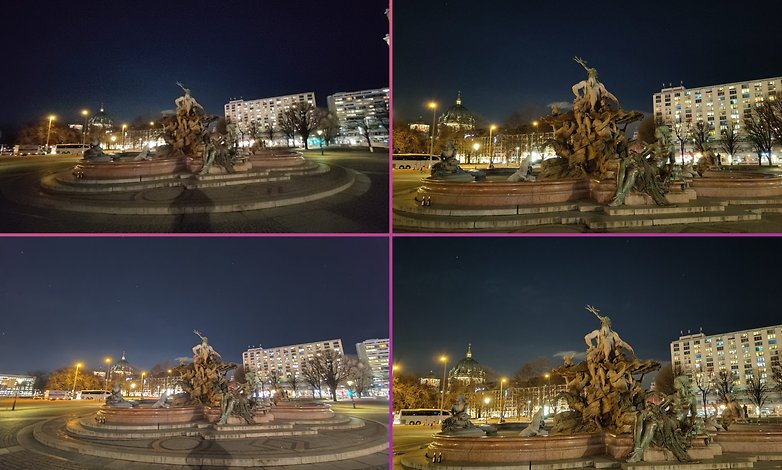
This year, I found that OnePlus has made some very clear progress in photography. I really liked the contrast, the wide dynamic range and the level of detail offered by the main sensor. The ultra wide angle and dedicated telephoto lens bring versatility that I appreciate, although the zoom is not the best on the market. I found the nighttime rendering to be worthy of the top of the line Android phones.
I'm sure OnePlus will benefit more from pushing its collaboration on hardware, designing specific components with Hasselblad and then calibrating them together. As it stands, the OnePlus 9 Pro is a very good photo smartphone, though I still wouldn't put it on the level of a Samsung Galaxy S21 Ultra.
Impressive battery life, and then there is 50W wireless charging!
The OnePlus 9 Pro packs a 4500mAh dual-cell battery and supports Warp Charge 65T fast wired charging and Warp Charge Wireless fast charging 50 Watts.
In short, I liked:
- the solid battery life despite the 120Hz AMOLED QHD+ display
- the Warp Charge 65T charging
I did not like:
- the 4500 mAh battery could have been bigger on the Pro model
- the 50 Watts fast charge is exclusive to the Pro model
4500 mAh, for a flagship in 2021 it's not ridiculous but it's still a bit disappointing especially since the basic version and the Pro model have the same charging capacity. You'd think that with a bigger screen and a higher price tag of 200 euros, the OnePlus 9 Pro would deserve a bigger battery.
But that's only 100 mAh less than the Xiaomi Mi 11's battery, and certainly, less than the 5000 mAh on the Samsung Galaxy S21 Plus/Ultra – except those also cost a lot more.
In conclusion, it's not bad but I would have liked a little more. On a day-to-day basis, the OnePlus 9 Pro lasted between 10 and 12 hours before dropping below the 20% remaining battery life mark. A more than respectable score while I was using the smartphone for my benchmark and photo tests with the QHD+/120 Hz screen.

The Warp Charge 65T wired fast charging has already debuted on the OnePlus 8T, which also has the same 4500 mAh dual-cell battery. I was able to charge the OnePlus 9 Pro from 0 to 100% in 30 minutes or slightly less, on average.
As for the Warp Charge Wireless 50 Watts, I unfortunately and very stupidly forgot to retrieve the wireless charger left at the office to bring it home. The manufacturer announces that it can charge the two cells of the battery in 25 Watts each and at the same time, allowing to pass from 1 to 100% of battery in 43 minutes.
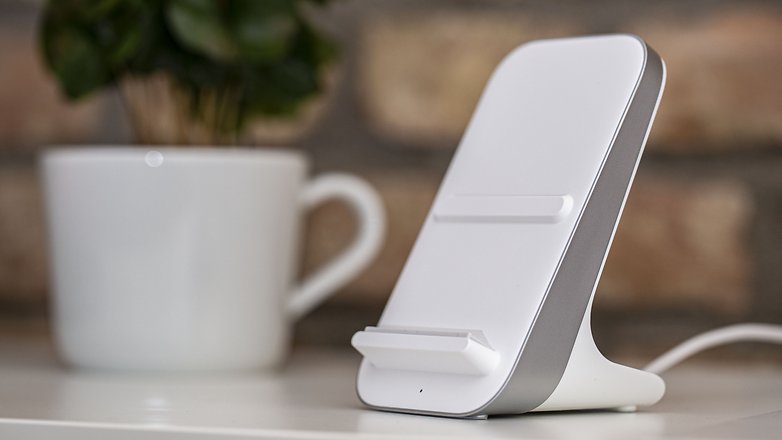
A very nice promise that, on paper is even more interesting than some wired charges and that I will try to test and then update this article.
Wireless charging on OnePlus flagships is no longer big news since the manufacturer has FINALLY offered it on the OnePlus 8 last year. Except this year, not only will it no longer be exclusive to the Pro model, but it will also be more powerful.
Overall, I found the battery life to be solid enough for its battery while the latter is far from impressive on paper. The Warp Charge 65T is as good as ever, and wireless charging takes a giant step forward from last year's OnePlus 8 Pro.
OnePlus 9 Pro specifications
OnePlus 9 and OnePlus 9 Pro
| Model | OnePlus 9 Pro |
|---|---|
| Processor | Snapdragon 888 |
| Memory |
|
| Expandable storage |
No, no microSD slot |
| Connectivity | 5G |
| Screen |
|
| Size | 163.2 x 73.6 x 8.7 mm |
| Weight | 192 grams |
| Camera |
|
| Video |
|
| Battery capacity | 4500 mAh |
| Charging technologies |
|
| Audio | Stereo speakers with Dolby Atmos / 3.5 mm headphone jack |
| IP certification | IP 68 |
| OS | OxygenOS 11 based on Android 11 |
| Price | from 899 euros |
Conclusion
My review of the OnePlus 9 Pro could have been limited to the photo part, as it's the only criterion where OnePlus wasn't yet on the same level as the top of the line Android devices.
This year, I find the OnePlus 9 Pro to be a more complete flagship than last year's OnePlus 8 Pro, and it offers one of the best price/performance ratios for a premium flagship. If I had to choose between a Samsung Galaxy S21 at 859 euros or invest 40 euros more for the OnePlus 9 Pro, I would not hesitate for a second to make the effort.
For all that, the hype around the Hasselblad camera module should be put into perspective, in my opinion. Yes, the OnePlus 9 Pro marks a real improvement in photography over its predecessors and outperforms direct competitors. But it's not the best camera on the market and I'd like to see even more improvements in the zoom, for example.
For the rest, it's a more powerful flagship than the Samsung Galaxy S21, more complete than the Xiaomi Mi 11 and cheaper than the Oppo Find X3 Pro.



















Great review. I've got the silver mist variant. Amazing performance. Only gripe is the glossy surface..Gotta invest in a Gadgetshieldz skin or Dbrand skin for protection.. Why do they even make glossy finishes ?? Camera quality is good but not worth the Hassleblad moniker.